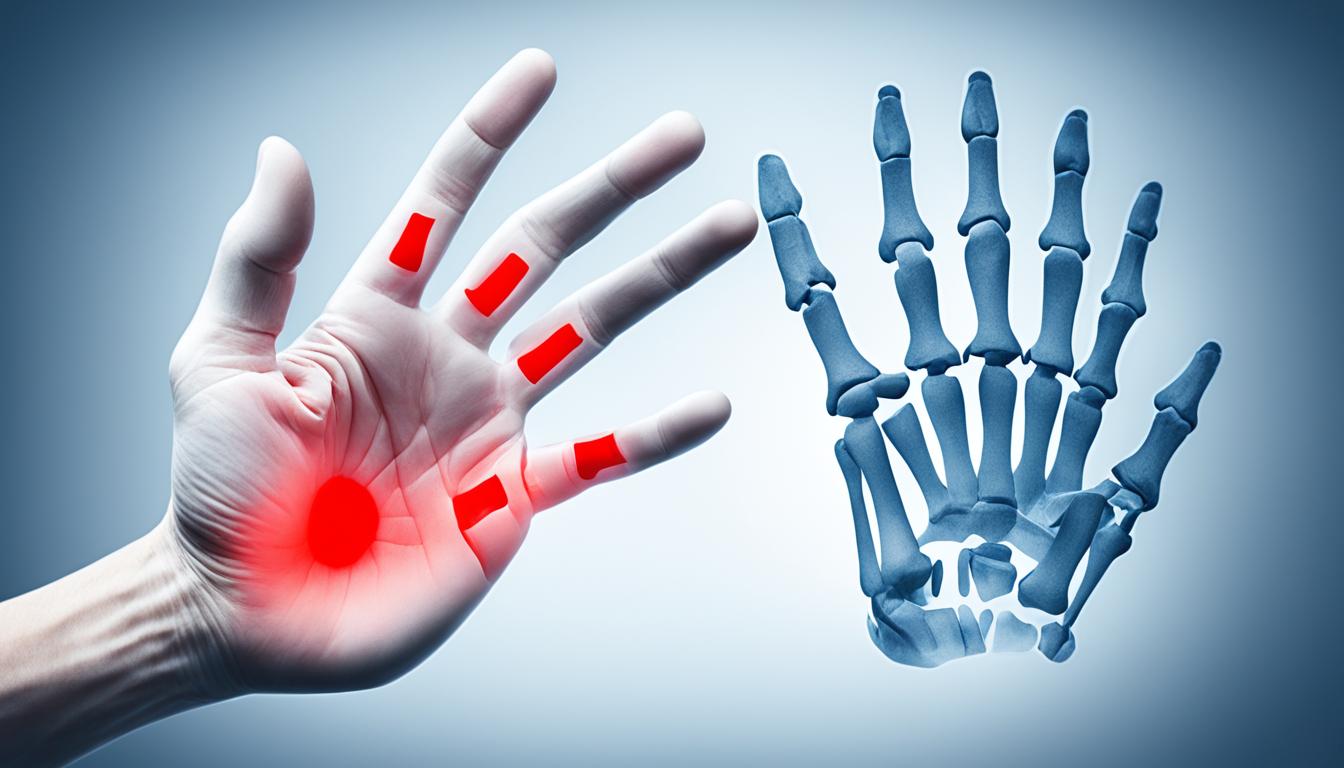A broken hand, or hand fracture, is a typical injury that hurts a lot and affects what we do every day. It’s commonly seen after a fall or when a hand is hit directly. Signs of a broken hand are pain, swelled up, turned black and blue, and trouble moving the hand or fingers. Sports, accidents, and fights are often why hands break.
Doctors sign off on a broken hand mainly by checking you over and taking X-rays. Fixing a broken hand can include simple things like wearing a splint or a cast, or surgery for bad breaks. Lately, new ways to heal hands quicker have come up, like using stem cells, offering a real hope for a fast recovery.
Key Takeaways:
- A broken hand, or hand fracture, is a common injury that can result from physical trauma.
- Common symptoms of a broken hand include pain, swelling, bruising, and difficulty moving the hand or fingers.
- Diagnosis of a broken hand involves physical examination, X-rays, and other imaging tests.
- Treatment options for a broken hand range from non-surgical methods to surgical intervention.
- Stem cell therapy offers a regenerative alternative for the treatment of hand fractures, promoting faster healing and recovery times.
Types of Hand Fractures and Their Causes
Hand fractures happen in many places and come in different severities. It’s key to know about them for the right treatment. Common kinds are metacarpal, phalanx, and carpal fractures.
1. Metacarpal Fractures
Metacarpal fractures are breaks in the long palm bones. They often happen from falls or hard hits. Sports, car accidents, and fights can also cause them.
2. Phalanx Fractures
Phalanx fractures are in the finger bones. They can happen from jammed fingers or intense hits during sports or accidents.
3. Carpal Fractures
Wrist bone breaks are called carpal fractures. They might happen from falling on a hand, car crashes, or hard wrist hits.
Treating hand fractures depends on the type and how bad they are. For mild cases, just a splint or cast might be enough to heal. But for more serious fractures, surgery could be needed. This could involve pins, plates, or screws to fix the bones.
To heal from a hand fracture, you need to follow a plan. This includes keeping the hand still, managing pain, therapy, and slowly getting back to normal. It’s crucial to do what your doctor says for the best healing.
| Type of Hand Fracture | Causes |
|---|---|
| Metacarpal Fractures | Falls, direct blows, sports injuries, car accidents, physical altercations |
| Phalanx Fractures | Jamming a finger, direct impacts during sports activities or accidents |
| Carpal Fractures | Falls on an outstretched hand, car accidents, direct traumatic impacts to the wrist |
Knowing about hand fractures and why they happen is very important. It helps in quickly finding the right treatment. This can range from a simple cast to more complex surgeries. The main goal is to get the best care for a full recovery.
Regenerative Stem Cell Therapy for Hand Fractures
Regenerative stem cell therapy is a new way to treat hand fractures. It’s different from surgery. Stem cells come from a person’s bone marrow. They help to fix the damaged hand tissue and speed up healing.
Stem cell therapy for hand fractures works by injecting many stem cells into the hurt part. These cells can turn into different types of cells, like bone cells. This helps the tissue grow back strong and healthy. Using stem cell therapy can heal the hand faster, lessen pain, and reduce swelling. It also helps the hand work better.
Stem cell therapy isn’t just for fractures. It also helps with hand and wrist arthritis. It does this by fixing the tissue and reducing the pain. This can make moving the hand and wrist easier.
These benefits happen without surgery. Stem cell therapy is easy and quick. It doesn’t take long to recover. This lets people get back to their normal life without much wait.
This therapy might also stop the hand and wrist from getting worse. That’s great news for those with ongoing issues like arthritis. By helping the tissue grow back, stem cell therapy makes the hand and wrist stronger. This improves how they work and quality of life.
But, how well this therapy works can change from one person to another. It depends on many things, like how bad the issue is and how the body reacts. Talk to a doctor to see if stem cell therapy could help your condition.
Conclusion
Broken hands are common and can really mess with our daily lives. We’ve always treated them with things like splints, casts, or surgery. But now, stem cell therapy is changing how we heal them without surgery. It’s making things heal quicker and work better.
Stem cell therapy works by putting strong stem cells right where you’re hurt. It helps your body grow new tissue and heal faster. It’s not just great for broken hands. It also helps with hand and wrist arthritis, making the pain less and function better.
Thanks to science, there’s now a good way to fix our hands without the pain of surgery. This way is safe and works well. By using the power of stem cells, we’re finding a way to let the body heal itself. It’s all about healing naturally and getting back to normal quickly.

